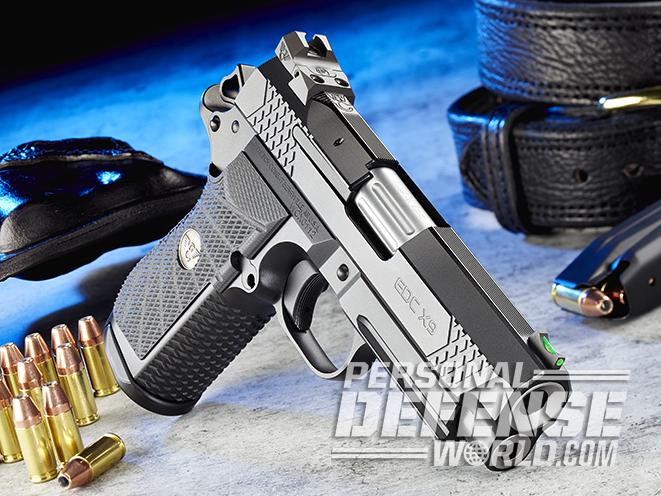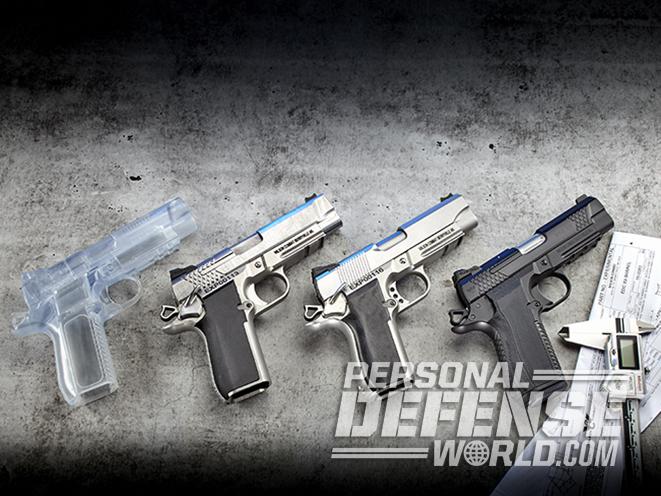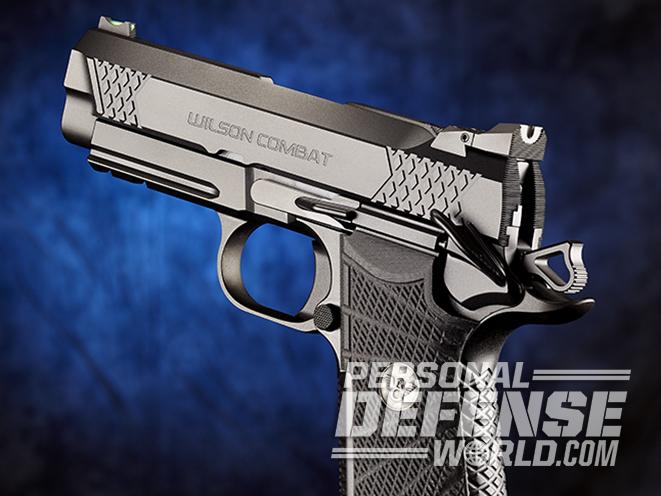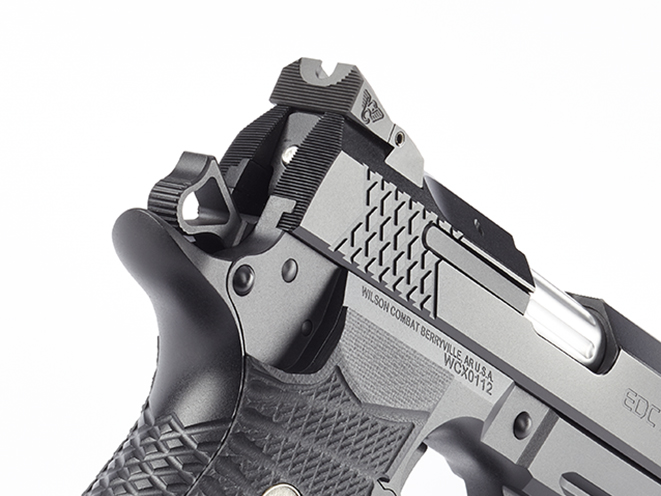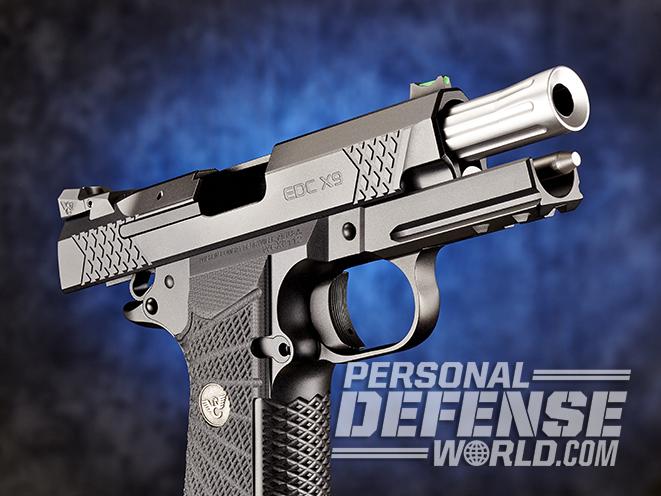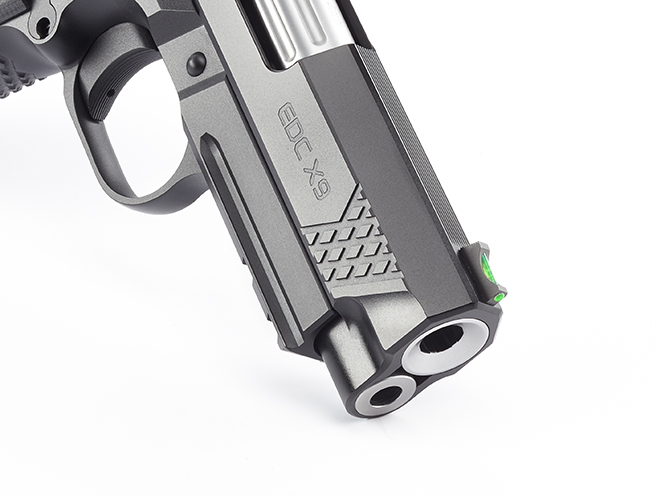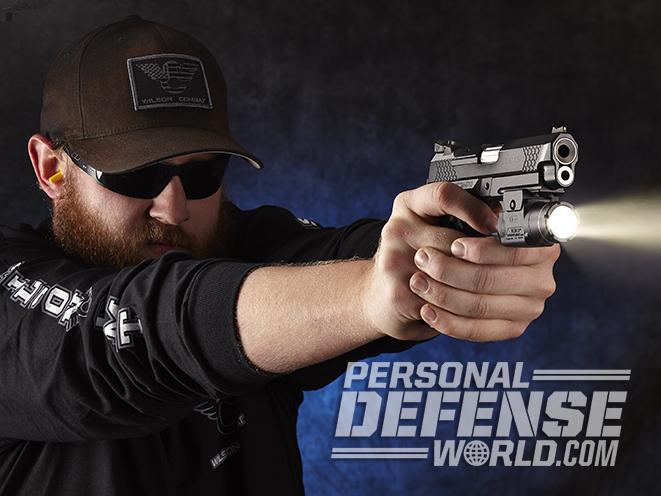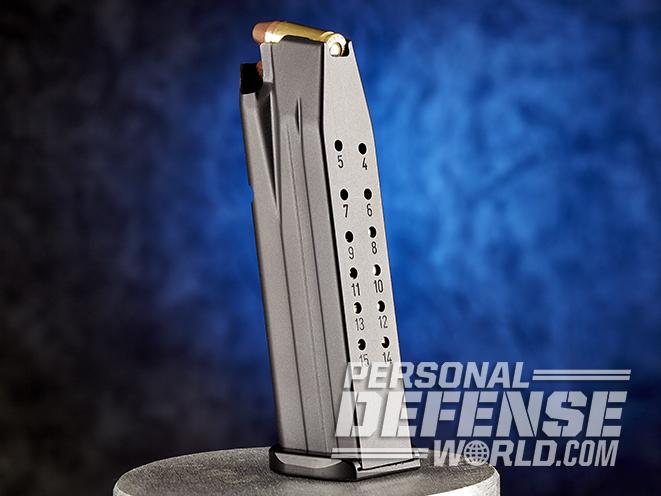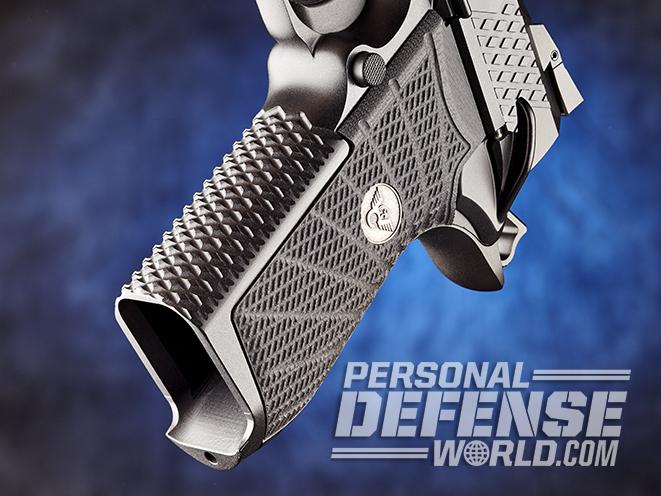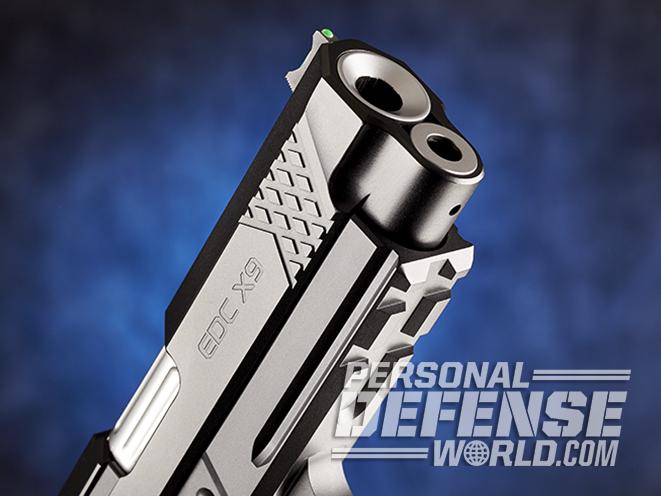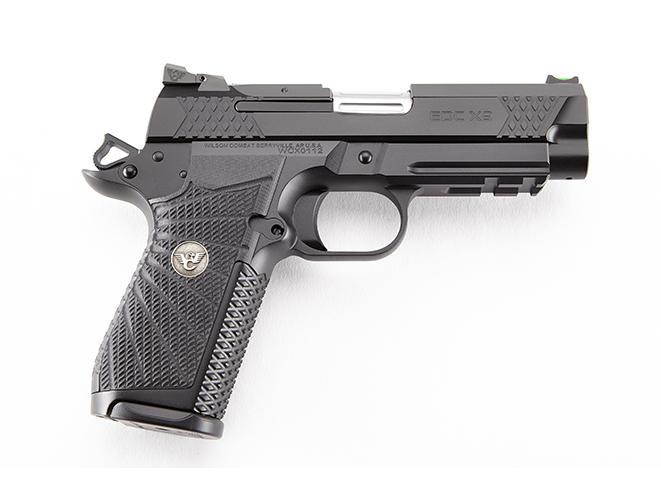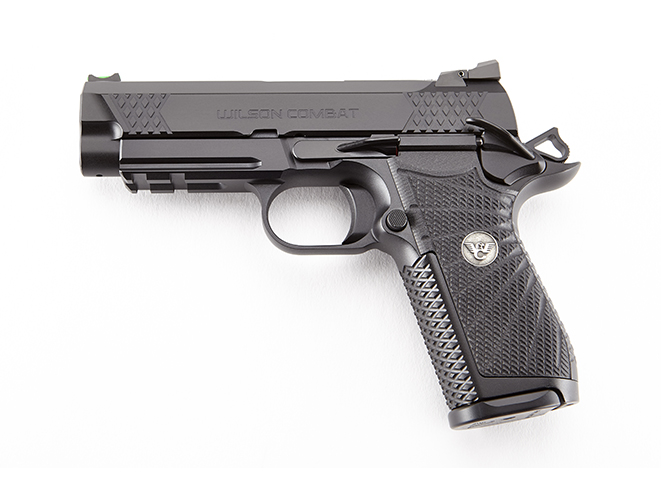Bill Wilson may have retired from running the daily operations at the company he founded in 1977, but there’s no doubt that he continues to help drive Wilson Combat’s research and development with several new firearms released in just the last year. The EDC X9 is unquestionably the most ambitious of the lot because it offers a fresh design that significantly departs from the 1911s that Wilson Combat and other competitive manufacturers now produce.
The EDC X9 project started in March 2015 and culminated in early 2017 after three working prototypes were made and thousands of rounds were sent downrange by multiple shooters. And the resulting pistol embodies Bill Wilson’s approach to gun-making, which attends to all the large and small details—both functional and aesthetic—needed to produce a memorable pistol.
A Higher Level
The EDC X9 elevates the 1911 design to a decidedly higher level by going down a proven path of reliability using design features that work. That’s certainly welcome because every year “groundbreaking” designs that supposedly solve some sort of problem get plenty of media attention only to undergo recalls as latent defects arise. New technology is a welcome thing, but not always on a carry pistol; Wilson made the EDC X9 a pistol you can bet your life on by selecting proven, not speculative, features.
Advertisement — Continue Reading Below
Dimensionally, the 9mm EDC X9 fits squarely in the compact pistol category, but with a grip size that belies its double-stack magazine. The length and height are 7.38 and 5.38 inches, respectively, making the pistol nearly identical to the Colt Commander. At 28.6 ounces unloaded, the EDC X9 weighs slightly less than the Colt Commander and also has a rounded rather than square butt to increase its concealability under lightweight garments.
Wilson’s new pistol holds significantly more rounds, but that doesn’t impact its grip dimensions unfavorably. The EDC X9 uses a double-stack, 15-round magazine, yet, at 1.4 inches wide, it matches the width of the single-stack, nine-round Commander. Surprisingly, the EDC X9’s grip width of 1.25 inches is just under the width of a standard 1911.
The EDC X9’s frame is 7075-T6 aluminum while the slide and barrel are made from a billet of stainless steel. All of the small parts, including the hammer, slide stop, magazine, thumb safety, ejector, magazine release, etc., are made by CNC milling. Consistent with every other Wilson Combat pistol, you won’t find any stamped, MIM or plastic parts in the EDC X9. The recoil spring has a flat profile and is made of chrome-silicon spring steel, which gives it a very long lifespan. The match-grade, 4-inch barrel has a deeply recessed muzzle to protect the crown from any accuracy-diminishing damage. The extractor is made from hardened S7 tool steel—the same material used for the tips of concrete breakers. This level of quality goes way beyond the norm for most 1911s.
Advertisement — Continue Reading Below
The EDC X9’s slide and frame are finished with Wilson’s black Armor-Tuff, a form of Cerakote. The slide has a triangular profile on top that, along with the barrel fluting, helps reduce weight for more comfortable carry. To help reduce glare, you’ll notice 40-lpi serrations along the top and rear of the slide as well as on the backsides of the sights. The bottom edges of the slide are also chamfered.
The sights on the EDC X9 are functional and easy to adjust or remove. The front sight has a green fiber-optic insert, though a red insert is also included and Wilson offers other sight options. The rear Battlesight, with its wide U-notch, is adjustable for elevation via a flat-head screwdriver and windage after loosening two Torx-head screws.
Instant Classic
The 1911 is undoubtedly one of the easiest-to-shoot pistols ever made. It points naturally, and its best qualities, namely the crisp trigger, thumb safety and beavertail grip, are preserved in the EDC X9. But this new pistol also eliminates some of the 1911’s shortcomings, including its time-consuming takedown process, need for adequate and proper lubrication, limited magazine capacity and small triggerguard.
Advertisement — Continue Reading Below
The EDC X9 also incorporates three significant features intended to make the 1911 more reliable and less maintenance intensive: a pivoting external extractor, a simplified slide-barrel locking system and reduced-length frame rails.
The extractor serves a vital role in any firearm and especially in a pistol. If it fails, you are left with a single-shot gun, and can’t expect to easily remove a fired case by hand. This is often caused by a worn surface on the extractor claw or a weakened spring that doesn’t adequately grip the rim of the cartridge with enough tension to extract it. The pivoting external extractor on the EDC X9 improves on the 1911’s internal extractor because the claw maintains adequate grip strength over a wider range of spring tension. Internal extractors can also be affected by debris that can lodge in a gap between the claw and the slide.
The 1911’s locking system uses two lugs on the barrel that engage two corresponding slots in the slide, and it is well documented that this pistol can seize up or become unreliable without regular cleaning and lubrication in this critical area. The EDC X9 replaces the two-lug design with a much simpler system where the top of the barrel just ahead of the chamber locks with the slide at the front of the ejection port. There are no hidden lugs—just two surfaces that are easily cleaned and lubricated. Moreover, according to Bill Wilson, this design not only reduces the need to oil your gun as much as a traditional 1911-style pistol, but it is also more forgiving if you use a lubricant that is too viscous for the temperature.
Advertisement — Continue Reading Below
Also, as a former watchmaker, Wilson understands how friction reduces the smooth movement of parts and addressed the slide rails, which accumulate dirt and powder fouling for increased friction. These frictional forces could presumably be made worse by customers who use the EDC X9 strictly for a daily-carry piece—exposing it to dirt, dust and lint—but follow the lax cleaning practices of owning looser-fitting polymer-framed pistols.
To reduce the effects of friction-related drag on the slide, Wilson removed about 1.38 inches from the middle section of the frame rails on both side of the magazine. Removing part of the middle section rather than the ends maintains the slide-to-frame fit, and the middle is precisely where the most dirt accumulates from the magazine well and powder fouling from the chamber. Wilson’s tests showed no reduction in accuracy from this modification.
As noted in his book “The Combat Auto,” Wilson explains that accuracy is almost completely a function of the barrel-to-slide fit, not frame-to-slide fit; thus, the removed rail section is inconsequential for accuracy but can improve reliability by reducing surface friction, especially when fouled. There’s another reason why this design could improve reliability: Tightly fitted pistols are more reliable than those loosely fitted where parts don’t align exactly the same way with each round fired. Wilson Combat pistols are tight and reliable, but like any tool with tight tolerances, they need cleaning. The frame rail reduction also offsets the possibility of less reliability from less regular maintenance.
Advertisement — Continue Reading Below
As an indication of how well this design works, one of the EDC X9 test pistols had zero malfunctions after firing 1,500 rounds without any cleaning or lubrication while two others each passed an endurance test in shooting over 10,000 rounds of hot ammunition without any unusual wear or damage.
For easier field-stripping, the EDC X9 uses a bushing-less barrel and a one-piece steel guide rod. There’s no need for a bushing wrench to take the pistol down and no hazards from a spring-tensioned guide rod plug being ejected, as with a traditional 1911. A full-length guide rod also keeps the recoil spring from snaking around the dust cover during recoil and abrading the finish. The EDC X9’s guide rod also has a Shok-Buff, a poly-fiber buffer that Bill Wilson uses on all of his pistols to reduce perceived recoil and cushion the frame from being battered by the recoiling slide.
Have It Your Way
Though reliability is the single most important element of a defensive pistol, it’s not the whole story on combat effectiveness. Perfect operation matters little if a pistol’s ergonomics and ease of shooting don’t let you place rounds where they’re intended to go, or if your gun holds fewer rounds than needed.
Advertisement — Continue Reading Below
Ammo capacity is a critical starting point for any combat handgun, and Bill Wilson wanted a pistol that held 15+1 rounds but without the dimensional bulk of the existing stable of double-stack 9mm 1911s. These competitive models have equivalent payloads to the EDC X9 but are made using wide-body frames designed to accommodate the thicker, longer .45 ACP cartridge. These frames are noticeably bulky and don’t provide the best control for many shooters. Though it’s true that defensive uses of a handgun are typically close-range encounters on relatively large targets, a pistol that fits your hand well will help you score a precise headshot or engage hostiles at greater distances.
Optimal gun fit means more than having a pistol that feels comfortable to hold—it also means being able to quickly access the pistol’s controls without changing your firing grip and position your trigger finger at a place where the trigger moves straight to the rear without pulling the sights off target. Wilson makes a good fit possible with the EDC X9 by offering two backstrap sizes—one for small/medium hands and one for large hands—along with three trigger lengths. Customers can decide how to configure the EDC X9 for their palm size and finger length when ordering, and they can also select an optional ambidextrous thumb safety.
Combat pistols are all-season implements, and the EDC X9 improves upon the 1911 by lengthening the triggerguard to better accommodate operation when using gloves. This is more important than it may seem, because a thicker, gloved trigger finger not only needs to quickly enter the triggerguard but also stay clear of the trigger when inserted. The EDC X9’s added room inside the guard provides extra space for safety when wearing gloves.
Advertisement — Continue Reading Below
Finally, the frame is improved with an undercut triggerguard that places the hand slightly higher to keep the muzzle from rising during recoil.
Rounds Downrange
The EDC X9 proved completely reliable over the course of shooting about 400 rounds without cleaning using six different loads from five different manufacturers. The loads varied with flat-nose, round-nose and hollow-point bullets from 80 to 147 grains. The EDC X9 even functioned when I intentionally limp-wristed the pistol to try to induce a stoppage, and fully loaded magazines easily inserted into the pistol with the slide closed, making tactical reloads easier than some other concealed-carry pistols. The slide lock, magazine release and thumb safety were easily accessible without a change in firing grip.
Though compact pistols are sometimes tested for mechanical accuracy from a benchrest, I dispensed with that formality for the EDC X9 since its intended use as a concealed-carry pistol made benchrest testing of less practical use and Wilson guarantees five-shot groups no larger than 1.5 inches at 25 yards from a rest.
Advertisement — Continue Reading Below
Shooting off-hand at 15 yards, the EDC X9 printed five-shot groups within 2.5 inches with Winchester and Black Hills 115-grain FMJs and sometimes scoring three shots within 1 inches. For me, these groups will undoubtedly be smaller using a production gun to better fit my hands with a longer trigger and a larger backstrap, and a trigger weight of 3.75 to 4.5 pounds compared to the 5.25-pound weight of the prototype pistol I used. The prototype trigger was good, but it has been improved with a redesigned sear.
Carry-Ready EDC X9
The EDC X9 reflects very good engineering using reliable technology, and 10,000-plus-round durability tests validates it. (By the time you read this, the round counts through these same pistols will be up to 20,000.) This pistol is also a result of a design and testing process that continually focuses on improvements—even at the margins. For instance, my pistol was a final prototype with only two additional planned design changes when I received it, but after two weeks of testing by about 14 different shooters and several thousand rounds downrange, the “final” version was improved yet again in small but meaningful ways. Some of these design changes could have gone unnoticed or overlooked by many, but instead they were corrected by a detailed performance evaluation and the critical, experienced eye Bill Wilson brings to the firearms that bear his name. For more information, visit wilsoncombat.com or call 800-955-4856.
Wilson Combat EDC X9 Specs
- Caliber: 9mm
- Barrel: 4 inches
- OA Length: 7.38 inches
- Weight: 28.6 ounces (empty)
- Grips: G10
- Sights: Fiber-optic front, Battlesight rear
- Action: SA
- Finish: Armor-Tuff
- Capacity: 15+1
- MSRP: $2,895
